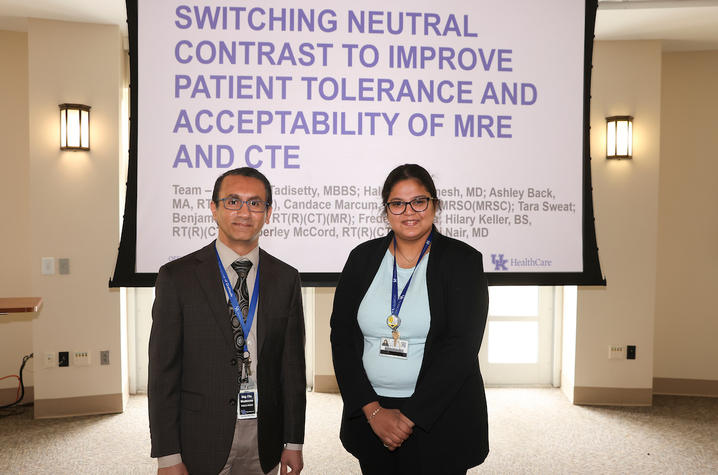Radiology Quality and Safety Showcase identifies opportunities for improvement, sustainability

Residents in the University of Kentucky College of Medicine Department of Radiology presented projects in the annual Rosenbaum Endowed Annual Department of Radiology Quality and Safety Showcase, an event in which residents, fellows, faculty and staff explore opportunities for potential improvement in quality and safety in radiological imaging and procedures. The presentations represented the culmination of efforts the Department of Radiology made during the past year to ensure UK HealthCare continues to offer the best comprehensive care in the Commonwealth.
Presentations included:
-
“Improving Appendicitis Ultrasound” by Luke Flood, Sophie Humphrey, and Jimmy Lee
-
“Save the Plastic Power Injector Trays” by Dillon Hickman, Drew Ison, Dolly Sturm, Leslie Anaskevich and Halemane Ganesh
-
“Improving Pediatric Intussusception Workflow” by Timothy Waits, Brendan Rhatican and Cesar Ong
-
“Resident Education for Body MRI Protocols” by Jaci Brainard and Andres Ayoob
-
“VIR Pre-Rotation Education for R1s” by Charles Myers and Roberto Galuppo
An additional, non-trainee project entitled “Switching Neutral Contrast to Improve Patient Tolerance and Acceptability of MRE and CTE” by Sindhura Tadisetty, Halemane Ganesh and Rashmi T. Nair was also presented.
“As the department vice chair and the quality and safety program officer, it's truly a privilege to be working alongside extremely talented teams who share the passion for quality and safety in medical imaging,” said Halemane Ganesh, M.D., associate professor in the Division of Abdominal Radiology. “This showcased the very high level of trainee and staff engagement and collaboration in the quality improvement processes.”
“Save the Plastic Power Injector Trays,” the presentation by Hickman, Ison and Sturm, was named the winning project, decided by a panel of judges who are experts in quality and safety. The team discovered that nearly 2,000 patients a month receive contrast injection for diagnostic imaging. The injector components come in plastic trays that could be recycled, but weren’t.
“We all have a responsibility to take care of our environment – that includes finding ways in health care to create sustainable processes,” said Dillon Hickman, M.D. “Drew Ison and Dolly Sturm identified an opportunity for recycling plastic power injector trays which is the packing for our power injector syringes in in UK HealthCare’s MRI and CT imaging facilities. Leslie Anaskevich, a co-chair of the UK Clinical Sustainability committee and director of Quality & Safety in the Department of Radiology, reached out to UK Recycling to set up a collection system for the recycled materials.”
The team discovered that the plastic trays were being removed from recycling bins and thrown away. They also worked to resolved to address the frequency in which the bins were picked up to avoid overflow. By identifying the issues, educating staff and providers and partnering with the university’s recycling division, they were able to reach a goal of 95% recycling compliance of the plastic power injector trays.
“One of the surprising things was that there are a lot of opportunities in the department and the institution that could be tackled to implement sustainability in medical imaging and reduce waste,” said Ganesh. “It was also surprising to note that there is a lot of desire to move in that direction and I’m pretty sure we will see more such projects in the coming years.”
Ganesh hopes that the ideas and practices showcased and implemented at UK HealthCare can be adopted by other healthcare institutions and lead to an overall improvement in radiological safety and sustainability. Collaborative efforts are underway with other units in hospital to improve quality and patient safety such as projects aimed at reducing radiation burden and repeat imaging for procedures such as feeding tube placements while preserving healthcare resources, addressing patients’ tolerance and satisfaction on certain types of CT and MRI scans, reducing work-related staff injuries and exploring other opportunities for recycling and sustainability.
Another project presented, “Improving Pediatric Intussusception Workflow,” examined the reporting procedure involving intussusceptions, a life-threatening condition in which the segments of the intestine fold in on each other like a telescope. Project leaders Timothy Waits, M.D., and Brendan Rhatican, M.D., found that the results of the imaging were reported to a staff member in the emergency department who then contacted the on-call pediatric radiologist. Under the new guidelines, the findings would be reported from the resident radiologist who conducted the imaging directly to the attending pediatric radiologist responsible for the procedure. By eliminating the extra step of reporting through a “middle person,” the line of communication is streamlined, reducing the time a patient needs to wait for treatment.
“I never liked the workflow for these intussusceptions and felt like we were delegating the responsibility to the emergency medicine team,” said Waits. “Our residents work with the pediatric radiologists on a regular basis and are familiar with the findings. There should be a direct line of communication between the radiologists to address any discrepancies in the findings as well as to decrease the potential for handoff issues. We take these cases very seriously and are always looking for ways to improve our workflow and reporting and thus improve patient care.”
“In many ways, radiology is the epicenter as imaging touches almost every patient coming through UK HealthCare,” said Ganesh. “As with any specialty, the pandemic posed new challenges for us in radiology, but we were also presented with opportunities for improvement by collaborating with other stakeholders.”
The 2023 Rosenbaum Endowed Annual Department of Radiology Quality and Safety Showcase marks the first in-person showcase since the start of the COVID-19 pandemic.
Credits
Words: Hillary Brown (Public Relations & Strategic Communication)
Photo: Mark Corneilson (UK Photo)

